Old water, new insights
Five years ago, an experiment began at ETH Hönggerberg: researchers set up an outdoor laboratory in the forest near the campus. They used sensors positioned in trees, the soil and in a stream to study water dynamics and the “old water paradox”. ETH News accompanied the head of the experiment, Marius Floriancic.
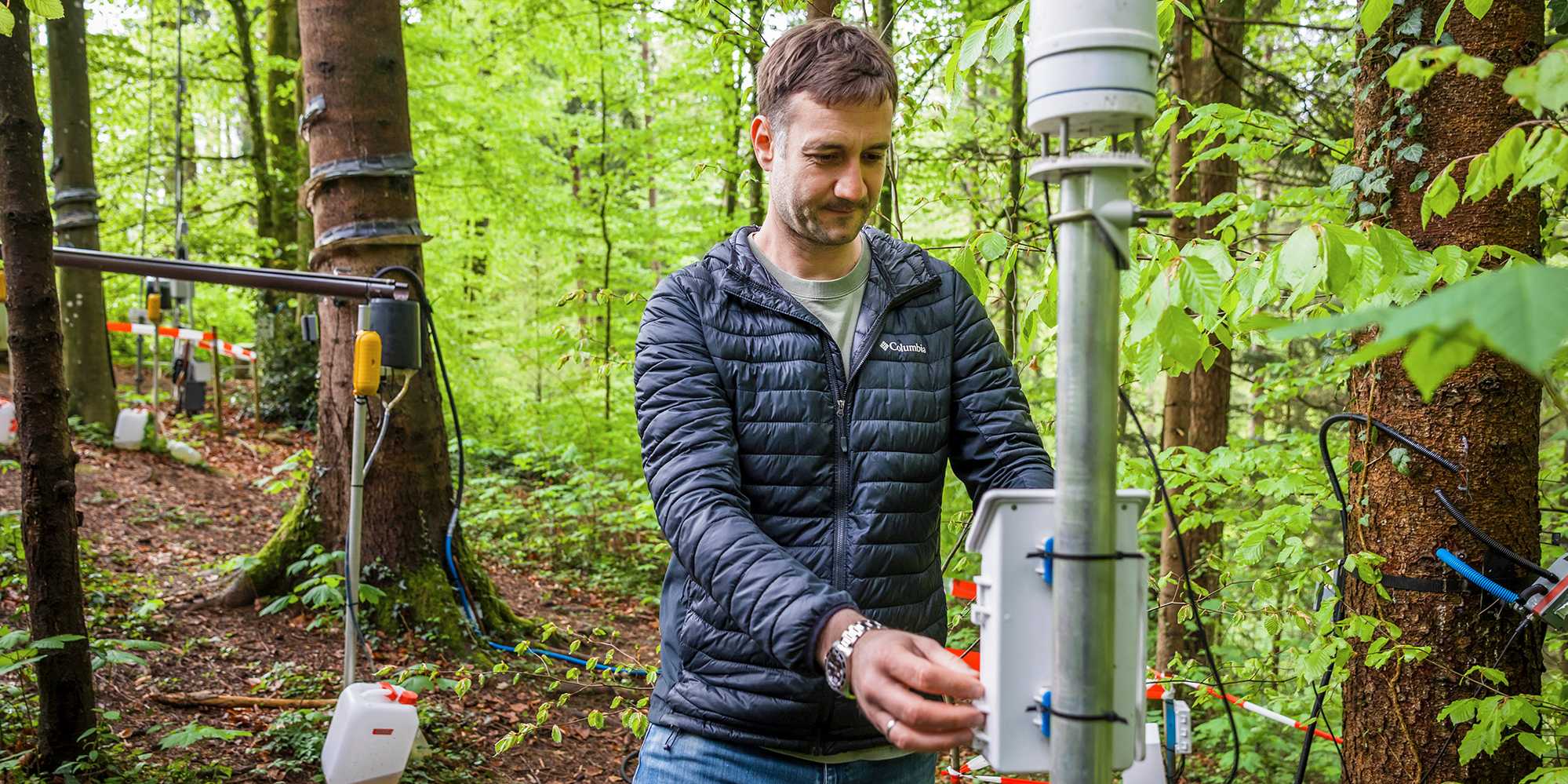
In brief
- In ETH Zurich’s “Waldlabor”, environmental engineers led by Marius Floriancic are using custom-built equipment to study water fluxes in the soil-plant-atmosphere continuum – a globally unique hydrology experiment.
- For a long time, forest soil hydrology was considered something of a mystery. Now, measurement data from the “Waldlabor” confirm what is known as the “old water paradox”.
- Soil samples show that most of the water is old – it has been stored in the ground for months or even years. Even at a depth of just ten centimetres, two-thirds of the water stored is more than three weeks old.
Marius Floriancic runs quickly along a narrow, well-trodden path, heading deeper and deeper into the forest. It is a cool, damp Thursday morning at the end of April; it rained the night before and water is still occasionally dripping down from the treetops above. After a few minutes, the path leads out into a clearing filled with several towering beeches and spruces. However, it is less the trees that catch the eye here, and more the electronics and technology strapped to the tree trunks or set up on the forest floor. Coloured cables drape over the branches, connecting sensors to rechargeable batteries tucked away in waterproof cases.
“This is the heart of our hydrology experiment in the ‘Waldlabor’,” explains the bright-eyed researcher, unable to hide his delight with the scientific playground that he has built with his group over the past five years. “From my office on the Hönggerberg campus, I can be here in about five minutes,” says Floriancic, Senior Research Assistant at the ETH Institute of Environmental Engineering, which is part of the Department of Civil, Environmental and Geomatic Engineering.
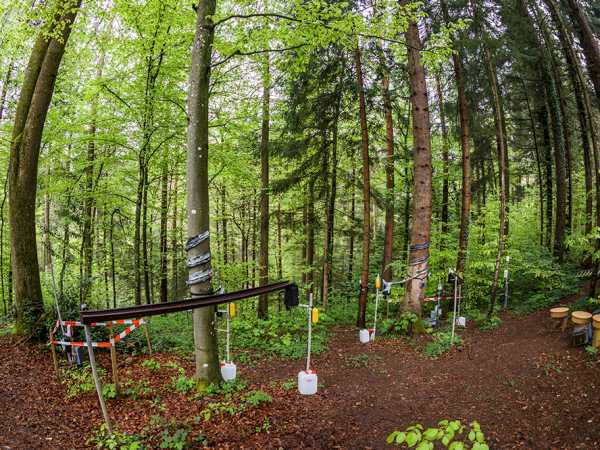 Marius Floriancic checks the sap flow meter and dendrometer on a root. (Image: Alessandro Della Bella / ETH Zurich)
Marius Floriancic checks the sap flow meter and dendrometer on a root. (Image: Alessandro Della Bella / ETH Zurich) Two connected temperature sensors are used to measure water flow in the tree trunk. (Image: Alessandro Della Bella / ETH Zurich)
Two connected temperature sensors are used to measure water flow in the tree trunk. (Image: Alessandro Della Bella / ETH Zurich) In summer, considerably less precipitation reaches the forest floor due to the forest canopy. (Image: Alessandro Della Bella / ETH Zurich)
In summer, considerably less precipitation reaches the forest floor due to the forest canopy. (Image: Alessandro Della Bella / ETH Zurich)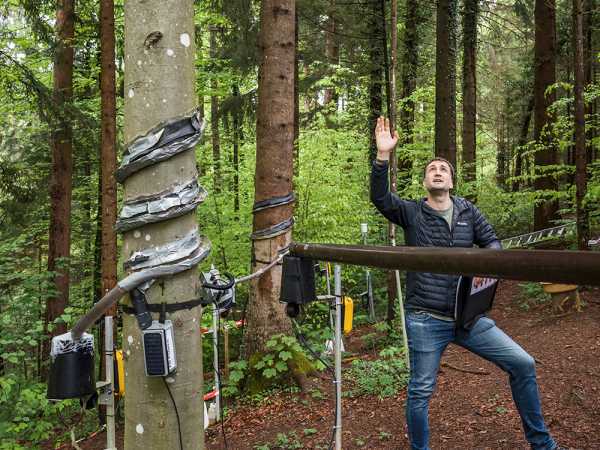 This set-up collects the water that runs down from the treetops, along the trunk and down to the soil. (Image: Alessandro Della Bella / ETH Zurich)
This set-up collects the water that runs down from the treetops, along the trunk and down to the soil. (Image: Alessandro Della Bella / ETH Zurich) Where there's duct tape, there's a way. standard measuring equipment does not always exist when it comes to hydrological forest research. (Image: Alessandro Della Bella / ETH Zurich)
Where there's duct tape, there's a way. standard measuring equipment does not always exist when it comes to hydrological forest research. (Image: Alessandro Della Bella / ETH Zurich)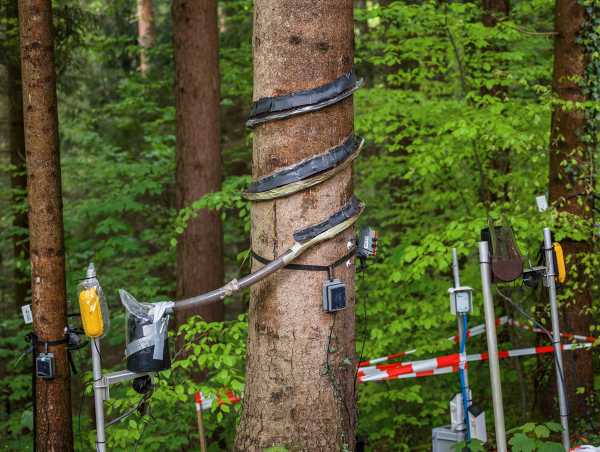 Precipitation levels and evaporation rates can be measured in the forest laboratory using lysimeters. (Image: Alessandro Della Bella / ETH Zurich)
Precipitation levels and evaporation rates can be measured in the forest laboratory using lysimeters. (Image: Alessandro Della Bella / ETH Zurich)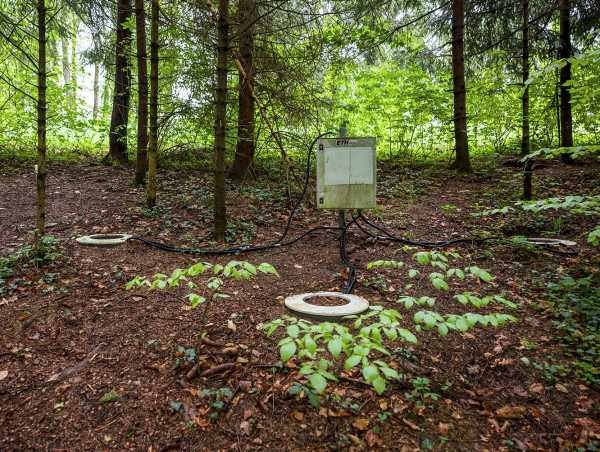 Floriancic uses this equipment to measure how ground cover influences the water budget. (Image: Alessandro Della Bella / ETH Zurich)
Floriancic uses this equipment to measure how ground cover influences the water budget. (Image: Alessandro Della Bella / ETH Zurich)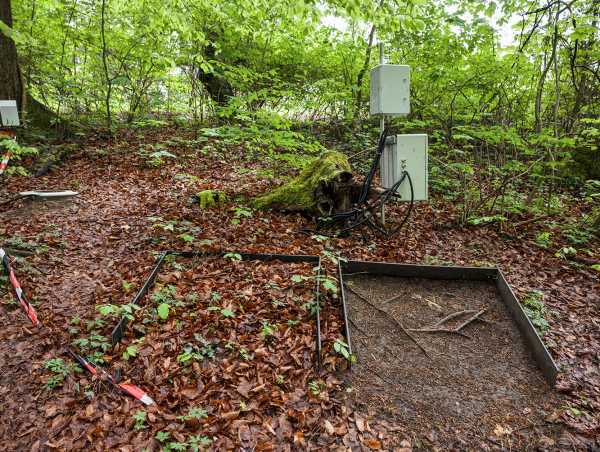 Sap flow and dendrometer measurements on a tree root. (Image: Alessandro Della Bella / ETH Zurich)
Sap flow and dendrometer measurements on a tree root. (Image: Alessandro Della Bella / ETH Zurich) The water potential in leaves can be determined using the “Scholander bomb”. (Image: Alessandro Della Bella / ETH Zurich)
The water potential in leaves can be determined using the “Scholander bomb”. (Image: Alessandro Della Bella / ETH Zurich) Hydrological measurements from the treetops to the forest floor. (Image: Alessandro Della Bella / ETH Zurich)
Hydrological measurements from the treetops to the forest floor. (Image: Alessandro Della Bella / ETH Zurich) Leaves ... (Image: Alessandro Della Bella / ETH Zurich)
Leaves ... (Image: Alessandro Della Bella / ETH Zurich)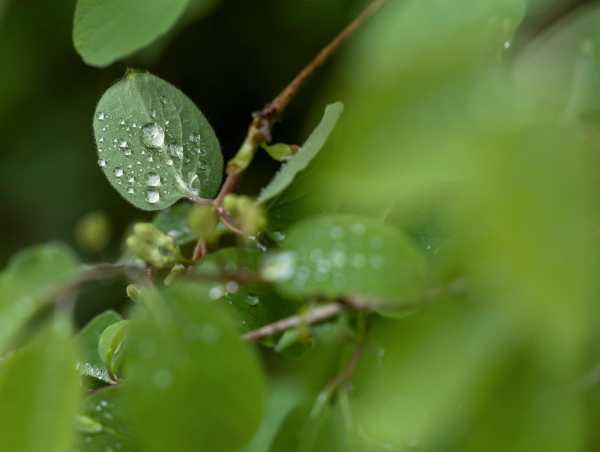 ... and pine needles retain a lot of precipitation, which causes a humid microclimate in the forest. (Image: Alessandro Della Bella / ETH Zurich)
... and pine needles retain a lot of precipitation, which causes a humid microclimate in the forest. (Image: Alessandro Della Bella / ETH Zurich)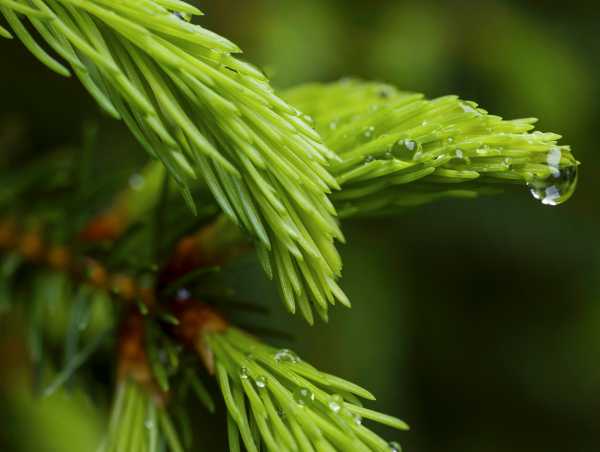 Floriancic checks the autosampler at the Holderbach stream. (Image: Alessandro Della Bella / ETH Zurich)
Floriancic checks the autosampler at the Holderbach stream. (Image: Alessandro Della Bella / ETH Zurich)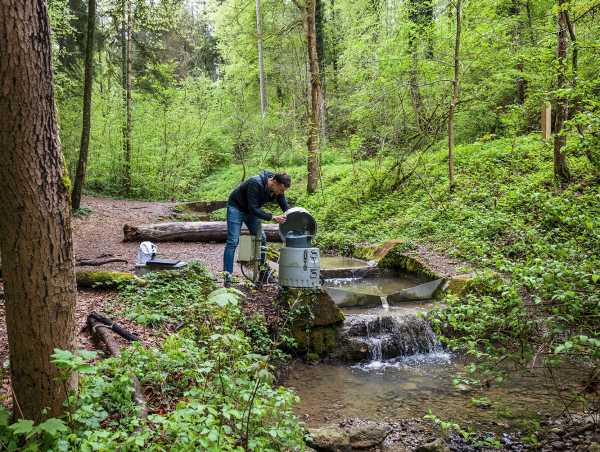 The stream’s water levels are monitored at groundwater measuring points. (Image: Alessandro Della Bella / ETH Zurich)
The stream’s water levels are monitored at groundwater measuring points. (Image: Alessandro Della Bella / ETH Zurich)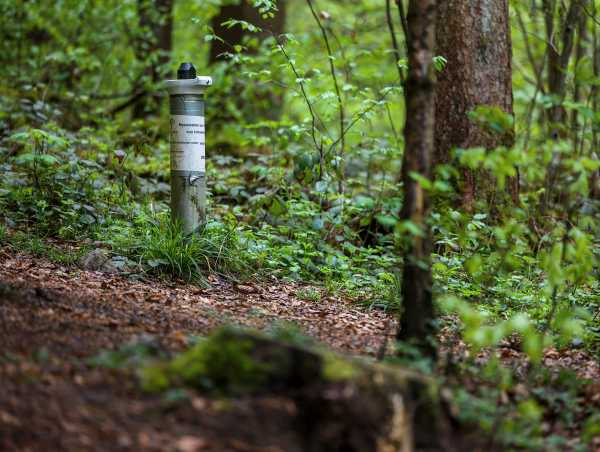
Both undergraduates and postgraduates can head into the forest whenever they like in order to take measurements or conduct new experiments. “There is nothing else like this in the world. Anywhere else, you would need to travel several hours between a university and a forest-based experimental site.” In this sense, the “Waldlabor” is also a godsend, allowing for the most hands-on education possible at ETH, which is something that Paola Passalacqua, the incoming Professor of Hydrology and River System Science, will further reinforce in future.
The fingerprints of old water
The researcher reveals several “suction cups” dug into the soil beside a beech tree. ”The series of measurements taken with this is what our lab is most proud of.” Using negative pressure, the cups draw water from depths of 10, 20, 40 and 80 centimetres. At the same time, samples of running water are taken from varying soil depths, using what is called a “Free Flow Sampler”.
Over the past five years, these soil water samples have been analysed for stable isotopes every week, giving researchers insights into their age, origin and the hydrological processes involved. The results show that the water has distinct “fingerprints”. The data give substance to the theory known among hydrologists as the “old water paradox”: the soil samples contain predominantly “old water”, which has been stored for months or years, and only very low amounts of “new water” from more recent precipitation.
A series of measurements from samples taken between April 2020 and April 2023 shows: even at a soil depth of ten centimetres, only a third of the water stored is younger than three weeks. “The soil hydrology in the forest has long been a black box,” says Floriancic. “Series of measurements such as these are therefore important for the whole research community.” All of the data from the past five years will be published and made freely available to researchers.
Five years of the “Waldlabor”
Since 2020, researchers have literally taken the pulse of the forest between Zurich-Höngg and Affoltern.
Several groups conduct research on questions of forest ecology, biology and hydrology in the “Waldlabor”, which stretches out over 1.5 square kilometres, and share their knowledge about sustainable forest management. The “Waldlabor” is designed to last for 100 years. It is funded by a non-profit organisation whose members include the research facilities of ETH Zurich and the Swiss Federal Institute for Forest, Snow and Landscape Research WSL; both forest owners, Grün Stadt Zurich and the Canton of Zurich; WaldZurich (Zurich Association of Forest Owners); and Verband Zürcher Forstpersonal (Zurich Association of Forestry Staff). Guided tours are regularly offered for groups, experts and schools. Countless people are to thank for making it possible to carry out these research activities at the “Waldlabor”.
Guided tours are regularly offered for groups, experts, and school classes. On 28 June 2025, Waldlabor will host the “external page Walderlebnistag” (“Public Forest Day”).
Find out more at: external page www.waldlabor.ch/ (in German)
The Holderbach stream flows around 200 metres beneath the clearing, with all its lysimeters, weather stations and soil and pressure sensors. Floriancic’s team installed an autosampler there, on the bank, that collects a water sample every six hours. Again, here, the samples are analysed for stable isotopes.
“We can observe the old water paradox here as well,” the environmental engineer explains. Even after a heavy thunderstorm, the major share of the water in the Holderbach stream is older than one month. And over the course of a year, just 14 percent of the runoff is younger than one month. The rest comes from the soil, where the water has been stored for at least a month.
In partnership with colleagues from the University of Natural Resources and Life Sciences (BOKU) in Vienna, Floriancic studied water samples collected from 32 Alpine catchments. The result: an average of 93 percent of the runoff water in Alpine rivers was older than one month. Only a small amount came from recent rainfall and snowmelt.
“While pores in the soil are filled with old water, new water quickly trickles down deeper and into the groundwater through holes caused by worms or roots,” explains Floriancic. This knowledge could improve flood mitigation planning.
Low-precipitation winters are devastating
Floriancic shows us a spiral-shaped chute that is fixed along a beech trunk with black duct tape. At the end, a hose is connected to a transparent plastic container. “A lot of things here are very “DIY” because standard measuring equipment often doesn’t exist for this kind of research.”
This set-up collects the water that flows from the treetop, along the trunk and down to the ground. The results are clear: soil water recharge is significantly higher in winter than in summer because the evaporation losses are lower and there is a lack of forest canopy cover. The forest floor predominantly receives its water supply in winter, particularly at a depth of between 10 and 80 centimetres. This is despite the fact that, on average, 60 percent of rainfall occurs in summer. Low-precipitation winters are especially troublesome for the trees because the ground is unable to store enough water to cope with the hot summer days.
However, it is not just the forest canopy that is important when it comes to forest hydrology – the litter layer is also significant. While it contributes heavily to creating a humid microclimate in the forest, it also causes less water to reach the soil, depending on its condition.
In order to prove this effect, the researchers surrounded several square parcels of soil with a metal frame and fitted each with an underground sensor. Some squares are covered with several centimetres of organic material, such as leaves, needles and cones. In others, the soil is left uncovered. “Hydrologists have long assumed that around three to four percent of precipitation is retained in the litter layer, and that this layer is therefore largely negligible,” explains Floriancic. His measurements, however, paint a different picture: around 18 percent of precipitation is stored in the litter layer and deadwood.
As a result, when accounting for the roughly 20 percent of precipitation that evaporates into the atmosphere after being caught by the leaves of the treetops, only 600 millilitres from every 1,000 actually reaches the soil. “This means that the forest floor is significantly drier than we’ve long thought it to be.”
Measuring water potential with the “Scholander bomb”
Floriancic’s team installed sap flow sensors on several tree trunks in order to better understand how trees take up and transport water. They inserted two interconnected sensors into the tree trunks to measure the temperature gradient, which can then be used to calculate water flow in the trunk.
At the same time, a dendrometer continuously measures the tree’s circumference and records when it expands due to water uptake, or contracts due to transpiration. There is even a kind of laboratory fume cupboard in the forest for additional tests. Hidden away in a sealed grey box chained to a tree is a “Scholander pressure bomb” – a heavy piece of measuring equipment that is connected to an oxygen cylinder. The researchers use this to determine leaf water potential, which allows them to draw conclusions about drought stress in the trees.
“Beeches and spruces are very different characters,” says Floriancic. Beeches are quite wasteful with water and keep the stomata on their leaves open longer for photosynthesis. Whereas spruces close their stomata earlier when there is drought stress in order to save water. But, as a result, they automatically photosynthesise less. This is, however, crucial for the tree’s growth and vitality.
Floriancic points to four yellow cylinders sticking out of the ground in front of a tall spruce tree. He squats down and lifts one of the covers. A root lies underneath that was uncovered incredibly carefully by a specialist company. It is fitted with a sap flow sensor and a dendrometer. The data gathered should help to better understand the water dynamics in the roots.
In January, one of Floriancic’s PhD students, Stefano Martinetti, published the first findings from these measurements: as the soil gets drier, trees absorb less water via their roots near the surface, and they activate deeper roots instead. What’s more, there is once again evidence of the old water paradox in the water isotopes.
“Even in very wet, rainy summers, we predominantly find old winter water in the roots and branches,” says Floriancic. The summer water mainly evaporates from surfaces and is taken up by the grasses and shrubs, whose roots are much shallower.
Soil quality is key to water storage
Floriancic says that the public are very interested in this local research. It is often not only students that he guides around the forest, but also foresters. “Even though we essentially carry out basic research here.”
One of the first questions the foresters usually ask is which trees will be most able to survive in future, considering the impacts of the climate crisis. To this, Floriancic answers that the research has not yet provided a clear answer; the research findings are still limited regarding future prospects for different tree species.
Nevertheless, he can already share some relevant findings from practical experience gained over the past five years of research: “Soil quality and structure are key to water storage. The more organic matter in the soil, the higher its water storage capacity.”
In this sense, having as much deadwood in the forest as possible is not only important for biodiversity, but also for water budgets. As one student’s methodical measurements show, this retains a lot of moisture.
In addition, combining various tree species is beneficial for the water budget, as their roots reach the soil water at different depths, meaning there is less competition between them. To put it another way: a more diverse forest is a more climate-resilient forest. For once, this is not a paradox, but rather the obvious added benefit of a high level of biodiversity.
References
Floriancic MG, Allen ST & Kirchner JW. Young and new water fractions in soil and hillslope waters; In: Hydrology and Earth System Sciences, Volume 28, issue 18, 2024. DOI: external page https://doi.org/10.5194/hess-28-4295-2024 .
Martinetti, S, Molnar, P, Carminati, A, Floriancic, MG. Contrasting the soil–plant hydraulics of beech and spruce by linking root water uptake to transpiration dynamics. In: Tree Physiology, Volume 45, Issue 1, 2025. DOI: external page https://doi.org/10.1093/treephys/tpae158
Visit the WaldLab Forest Experimental Site website to find all published findings from the hydrological experiment conducted in the forest laboratory.